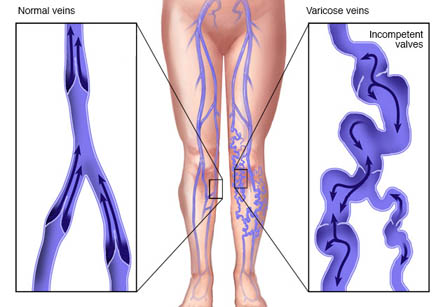Sclerotherapy
Introduction
Varicose veins and spider veins both can be treated with a well-proven surgical procedure called Sclerotherapy.
Methodology
This procedure needs to be performed in a hospital setting or surgeon’s treatment centre. The surgeon injects a solution or a sclerosant directly into the affected vessel. The solution irritates the lining of the vessel, causing it to swell and stick together. The vessel gradually turns into scar tissue which eventually fades out at sight.
Sclerotherapy involves an injection of a solution (generally a salt solution) directly into the vein

• The part of the body to be treated is cleansed.
• A very fine needle is used to inject the solution is injected directly into the blood vessel.
• The number of veins injected in one session can be different, depending on the size and location of the veins, and the patient’s overall medical condition.
Eligibility for sclerotherapy:
Varicose veins patients or spider veins patients if have had a blood clot earlier, the eligibility for sclerotherapy depends on the extremity and the cause of the clot. Surgeon will take a decision in this case as per individual case.
Contra-indications:
One cannot opt for sclerotherapy if pregnant, breastfeeding or bedridden. Pregnant females must wait at least three months post-delivery before they consider opting for this surgery. Females take oral contraceptives can undergo sclerotherapy.
Success of sclerotherapy
Larger injected veins may become lumpy or stiff for several months before they go back to normalcy.
It shows a good success rate. Almost 50-80% of damaged veins can be removed with each injection. Only a few sclerotherapy patients do not respond to the injections at all. Different method or different sclerosant can be used in such cases.
Patients with spider veins generally take 3 to 6 weeks to respond to the treatment, whereas larger vein patients respond in may be 3 to 4 months. If the veins respond to the treatment, they do not recur.
Pre-surgery care
• Antibiotics like tetracycline or minocin, if taken 7 to 10 days before or after sclerotherapy, can cause a staining of the skin.
• Aspirin, ibuprofen or other anti-inflammatory medications should better be avoided for 48 hours before and after the sclerotherapy, as these drugs may interfere with the action of the sclerosant or even may cause an increase in bleeding.
• Prednisone has found to decrease the efficiency of the sclerosant.
• No ointment should be applied to the legs before or after sclerotherapy.
Side effects of sclerotherapy
• Small blood vessels may show up temporarily on the site of treatment. Medically it is known as revascularization, mats, blushing or flares. They may appear days or weeks after the procedure but should fade within a few months and usually do not require any further treatment.
• Larger injected veins may become lumpy or stiff for several months before they go back to normalcy.
• Injection site can show some bruising and can possibly last for many days or weeks.
• Brown lines or spots on the skin can be seen at the site of the injection, possibly caused by a form of iron that escapes from the blood in the injected veins. In most cases, they disappear within 3 to 6 months, but can be permanent about 5 percent of the time.
• Raised, red areas may appear at the injection sites and should disappear within a few days.
• Allergic reactions to the sclerosant may occur at the time of the injection and are rarely serious. Symptoms include itching and swelling.
Some rare side effects developing after sclerotherapy are:
• Sudden onset of a swollen leg
• Inflammation within five inches of the groin
• Red streaking, especially in the groin area
• Formation of small ulcers at the injection site